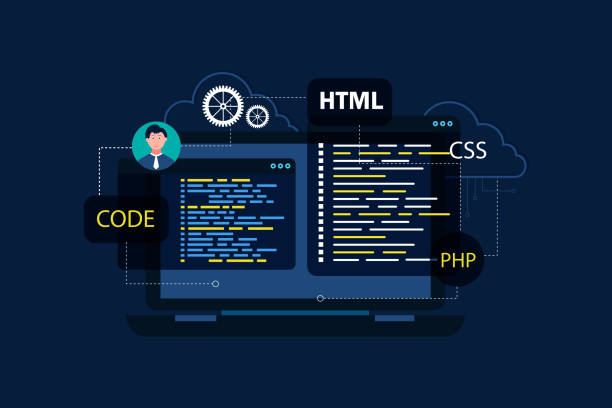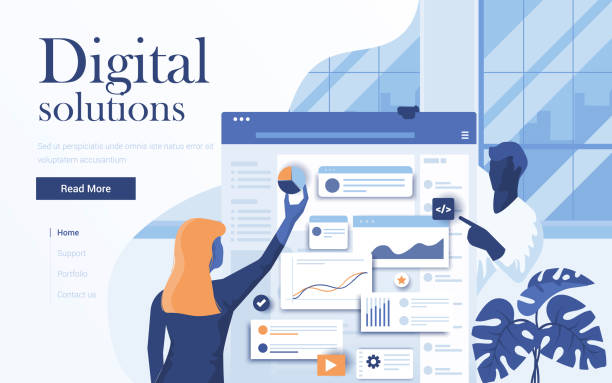The Fundamental Importance of Secure Website Design in the Digital Age

In today’s world, where digital boundaries are constantly expanding, the importance of #Secure_Website_Design is becoming increasingly evident.
Websites are not just showcases for businesses, but also crucial platforms for vital interactions and the exchange of sensitive information.
Neglecting this can lead to irreversible consequences, including loss of customer data, privacy breaches, and even damage to an organization’s reputation.
Therefore, every website project must incorporate security considerations at its core from the very initial stages.
This section, in an explanatory and educational manner, explores why security is vital in web design and states why investing in this area is not an expense, but a critical necessity for survival and growth in the online space.
Cybersecurity is no longer an option, but an integral part of the infrastructure of any modern business.
Without a strong foundation in secure website design, any structure will be vulnerable to cyberattacks.
This proactive approach builds user trust and protects valuable digital assets.
The main goal of this section is to clarify the fact that security is not a product to be added, but a process that must be woven into all stages of web development, from initial planning to deployment and maintenance.
Don’t have a corporate website yet and missing out on online opportunities? With professional corporate website design by Rasawweb,
✅ Double your business credibility
✅ Attract new customers
⚡ Free consultation for your corporate website!
Understanding Common Threats and Web Vulnerabilities

To achieve secure website design, one must first know the enemy.
#Understanding_Cyber_Threats and #Website_Vulnerabilities are the first steps toward creating a resilient platform.
SQL Injection and XSS (Cross-Site Scripting) are just two examples of the most common threats websites face.
Other important vulnerabilities include #weak_session_management, misconfigured servers, and the use of outdated components.
This section analytically and specializedly examines these threats and explains how they work so that developers and web administrators can identify potential weaknesses in their systems.
Understanding these attack mechanisms helps us implement more effective defense strategies.
The OWASP Top 10 Project, as a reputable reference, provides a list of the most common and critical web security vulnerabilities, which is essential reading for anyone involved in securing websites.
Familiarity with these threats is vital not only for programmers but for all stakeholders in a web project to make informed decisions about security solutions.
This insight forms the foundation of any successful strategy for protecting information and user trust.
Specialized Solutions for Secure Coding and Proactive Development

After understanding the threats, it’s time to implement #Practical_Solutions for #Secure_Coding and proactive development in the secure website design process.
This section, providing specialized and guidance, addresses topics such as Input Validation, using Prepared Statements to prevent SQL Injection, and Output Encoding to counter XSS.
Securing websites requires a comprehensive approach from developers.
Secure design principles must begin from the very first line of code and be implemented across all software layers.
This includes using trusted frameworks, continuous updating of libraries and components, and conducting regular security reviews throughout the Software Development Life Cycle (SDLC).
Proper implementation of these principles not only reduces vulnerabilities but also significantly lowers future costs associated with fixing security issues.
| Security Principle | Explanation | Example/Application |
|---|---|---|
| Input Validation | Thorough examination of all user input data to prevent attacks | Filtering special characters, checking data length and type |
| Using Prepared Statements | Separating SQL code from input data to prevent SQL Injection | Using PDO in PHP or JDBC in Java for database operations |
| Output Encoding | Converting special characters in output to a safe format for browser display | Using htmlspecialchars() in PHP to prevent XSS |
| Proper Error Management | Preventing the display of sensitive information in error messages to the user | Logging errors on the server instead of public display |
The Essential Role of SSL/TLS Certificates and Secure Hosting

One of the most basic, yet critical steps in #Website_Security and #secure_website_design is the use of SSL/TLS certificates.
These certificates encrypt the communication between the user’s browser and the website server, ensuring that exchanged data, including personal and payment information, remains protected against eavesdropping and tampering.
The presence of a green lock symbol in the browser’s address bar indicates a secure connection and significantly increases user trust.
This section, in an educational and explanatory manner, addresses the importance of SSL/TLS and how it works, and introduces different types of certificates.
In addition to SSL/TLS, choosing a secure and reliable hosting plays a very important role in your website’s stability and security.
Hosting providers must have strong security measures, including firewalls, intrusion detection systems, regular backups, and 24/7 server monitoring.
A weak hosting service can make your website vulnerable to DDoS attacks, malware, and other threats, even if your coding is completely secure.
Therefore, in the secure website design process, attention to web hosting infrastructure is as important as the website’s code itself.
Does your current site showcase your brand’s credibility as it should? Or does it drive away potential customers?
Rasawweb, with years of experience in professional corporate website design, is your comprehensive solution.
✅ A modern, beautiful, and brand-consistent website
✅ Significant increase in lead and new customer acquisition
⚡ Contact Rasawweb now for a free corporate website design consultation!
Authentication and Access Authorization in Web Systems

#Authentication and #Access_Authorization_Management are two main pillars in #Website_Security and secure website design that prevent unauthorized access to sensitive information and functionalities.
This section, providing specialized and guidance, examines methods for implementing strong authentication systems.
Using Multi-Factor Authentication (MFA), secure password storage (such as using strong hashing functions and Salting), and implementing password complexity policies are among the most important solutions.
The authorization management system must also be designed so that each user or role is limited to the minimum necessary access to perform their tasks (principle of least privilege).
Failure to adhere to these principles can lead to attacks such as Brute-Force, Credential Stuffing, or Escalation of Privileges, which will have irreversible consequences for a secure website.
Therefore, developers must carefully design the architecture of these systems and utilize proven and industry-standard solutions.
Furthermore, continuous monitoring of user activities and logins to identify suspicious patterns is a vital part of this process.
These measures create a strong layer against potential intrusions and protect sensitive data.
The Importance of Regular Security Audits and Penetration Testing

Even with the best approaches to secure website design and secure coding implementation, new vulnerabilities can emerge or hidden weaknesses may be discovered.
Therefore, #Regular_Security_Audits and #Penetration_Testing are integral parts of the life cycle of a secure website.
This section, in an informative and analytical manner, addresses how Penetration Testing simulates real attacks to identify and report existing weaknesses and vulnerabilities in the system before real attackers discover them.
These tests can include manual tests, use of automated vulnerability scanning tools, and code review.
In addition to penetration testing, Security Audits involve reviewing an organization’s existing security policies, procedures, and controls to ensure their compliance with standards and best practices.
This proactive approach helps organizations always stay one step ahead of attackers and continuously improve their system’s overall security level.
Neglecting this stage can nullify all efforts in securing websites and expose the website to serious risks.
In fact, security is an ongoing process, not a fixed destination, and these tests are a vital part of that continuous process.
Data Privacy and Regulatory Compliance

Alongside technical security, #Data_Privacy and #Privacy_Regulations_Compliance (such as GDPR) are of particular importance in secure website design.
This section, in a specialized and question-provoking content manner, addresses how websites should collect, store, and process user data to be both legally compliant and maintain user trust.
Are we transparent enough with our users about how their data is used? Can we guarantee that their data will never be misused or disclosed?
Implementing Data Encryption, both in transit and at rest, restricting access to sensitive data, and having a clear and understandable privacy policy are among the requirements in this area.
Compliance with global regulations such as GDPR or CCPA not only prevents heavy legal penalties but also demonstrates an organization’s commitment to protecting user rights.
Secure website design must, from the outset, incorporate “Privacy by Design”, meaning that privacy considerations are taken into account at all stages of web development, from conceptualization to implementation.
This approach builds the foundation for a stable and trust-based relationship with users.
| Topic | Importance in Secure Website Design | Practical Solution |
|---|---|---|
| User Consent | Collecting and processing data only with explicit and informed user consent | Cookie banner, clear consent forms, opt-out option |
| User Rights | Ability for users to access, correct, delete, and transfer their data | User portal for data management, data request process |
| Data Security | Protecting data from unauthorized access, disclosure, or destruction | Encryption, access control, regular backups, penetration testing |
| Transparency | Providing clear information on how data is collected and used | Accessible and understandable privacy policy |
Familiarity with Firewalls and WAF in Website Protection

In the secure website design ecosystem, #Firewalls and #WAF (Web Application Firewall) play a vital role in creating a robust defensive layer.
This section, in an educational and specialized manner, examines how these tools protect websites against various attacks.
Network Firewalls filter incoming and outgoing traffic based on predefined rules, but WAFs are specifically designed to protect web applications from application layer (Layer 7) attacks such as SQL Injection, XSS, and DDoS attacks.
WAFs identify and block malicious requests by analyzing and inspecting HTTP/HTTPS traffic, acting as a protective shield between users and your web server.
Implementing a WAF, whether as software, hardware, or cloud-based, can significantly enhance your website security level.
They can also serve as a central control point for enforcing security policies and even virtual patching for known vulnerabilities until a permanent patch is applied by developers.
Proper selection and configuration of these tools are key actions in the securing websites process and can prevent many common attacks.
Are you concerned about your e-commerce site’s low conversion rate and not achieving your desired sales?
Rasawweb is your specialized solution for a successful e-commerce website.
✅ Significant increase in conversion rate and sales
✅ Professional and user-friendly design to ensure customer satisfaction
⚡ Ready for a transformation in online sales? Get a free consultation!
Incident Response and Disaster Recovery Planning

Even with the most advanced secure website design solutions, the possibility of security incidents is not entirely zero.
Therefore, #Incident_Response_Plan and #Disaster_Recovery_Plan are of paramount importance.
This section, providing guidance and explanatory content, elaborates on the necessity of having a structured plan to deal with intrusions, data loss, or other security disruptions.
An effective incident response plan includes stages of identification, containment, eradication, recovery, and post-incident analysis.
Having clear procedures and responsible teams significantly reduces response time and minimizes potential damage.
The disaster recovery plan also ensures that in the event of a major occurrence (such as server failure, widespread cyberattack, or natural disasters), the website and its critical data are quickly recovered with minimal disruption.
This includes strategies for regular off-site backups, data recovery capabilities, and plans for restoring systems to operational status.
These plans should be regularly tested and updated to be effective when needed.
Neglecting these aspects in securing websites can lead to complete data loss, prolonged service outages, and loss of reputation.
Preparation is key to success in facing security challenges.
Future Trends in Web Security and Continuous Improvement

The field of cybersecurity and #secure_website_design is constantly evolving.
With the advent of new technologies such as Artificial Intelligence, blockchain, and quantum computing, security threats are also becoming more complex and intelligent.
This section, in an engaging and informative manner, explores #Future_Web_Security_Trends and the importance of #Continuous_Improvement in this area.
We live in an age where technological innovations are moving at a breathtaking pace; can we keep up with the attackers? How can we use emerging technologies to strengthen our defenses?
One of the most important future trends is the use of artificial intelligence and machine learning to detect anomalies and predict cyberattacks.
These technologies can identify malicious traffic patterns and initiate automated responses.
Also, increased use of Content Delivery Networks (CDN) with built-in security features and the concept of “Security by Design,” which is considered from the very beginning at all stages of product development, are other important trends.
To maintain a secure website, organizations must adopt a mindset of adaptability and continuous learning and actively invest in training their teams and updating security infrastructures.
The future of web security depends on innovation, cooperation, and preparedness for unknown challenges.
Frequently Asked Questions
| Question | Answer |
|---|---|
| What is secure website design? | Secure website design is a process in which websites are built considering security principles to be resilient against cyberattacks and to protect user and business information. |
| Why is secure website design of high importance? | To prevent unauthorized data access, sensitive information leaks, malware attacks, loss of user trust, damage to business reputation, and legal consequences resulting from data breaches. |
| What are the most common website vulnerabilities? | SQL Injection, Cross-Site Scripting (XSS), Cross-Site Request Forgery (CSRF), broken authentication and session management, and sensitive data exposure. |
| How can SQL Injection attacks be prevented? | Using Prepared Statements with parameterized queries, input validation, and restricting database access. |
| What are the methods to combat XSS (Cross-Site Scripting) attacks? | User input validation, output encoding before displaying in HTML, and using Content Security Policy (CSP). |
| What is the role of HTTPS in website security? | HTTPS, using an SSL/TLS certificate, encrypts the communication between the user’s browser and the website server, preventing eavesdropping, tampering, or spoofing of data. |
| What are the best practices for user password management? | Enforcing strong passwords (a combination of letters, numbers, and symbols), hashing passwords instead of direct storage (with strong algorithms like bcrypt), and enabling two-factor authentication (2FA). |
| What is the importance of user input validation? | Input validation prevents malicious or unexpected data from entering the system, which can lead to vulnerabilities such as SQL Injection or XSS. |
| What impact do regular security reviews and audits have on site security? | These reviews help in early identification of vulnerabilities and security weaknesses, allowing them to be fixed before they can be exploited. |
| What is the application of Web Application Firewall (WAF) in secure website design? | A WAF acts as a protective layer between the user and the website, analyzing incoming traffic and identifying and blocking common web attacks like SQL Injection and XSS. |
And other services of Rasaweb Advertising Agency in the field of advertising
Smart Custom Software: A fast and efficient solution for customer acquisition, focusing on marketing automation.
Smart Conversion Rate Optimization: Designed for businesses seeking to attract customers through user experience customization.
Smart Conversion Rate Optimization: A dedicated service for increasing website traffic growth based on custom programming.
Smart Google Ads: A dedicated service for increasing website traffic growth based on real data utilization.
Smart Direct Marketing: A professional solution for SEO rank improvement focusing on attractive user interface design.
And over hundreds of other services in the field of internet advertising, advertising consultation, and organizational solutions.
Internet Advertising | Advertising Strategy | Advertorial
Resources
- Secure Website Design
- Sustainable Web Development
- Comprehensive Web Design
- A Path to the Digital Future
? Ready to shine and achieve sustainable growth in the digital world? Rasaweb Afarin Digital Marketing Agency, with its expertise in providing comprehensive services including SEO-optimized website design, Search Engine Optimization (SEO), and targeted advertising campaigns, is your reliable partner on the path to online success.
📍 Tehran, Mirdamad Street, Next to Central Bank, Southern Kazeroun Alley, Ramin Alley, No. 6



